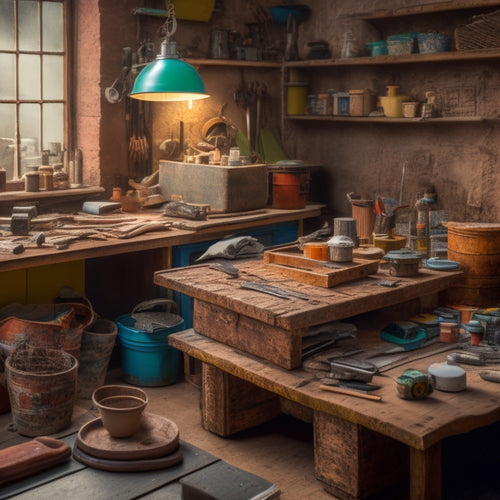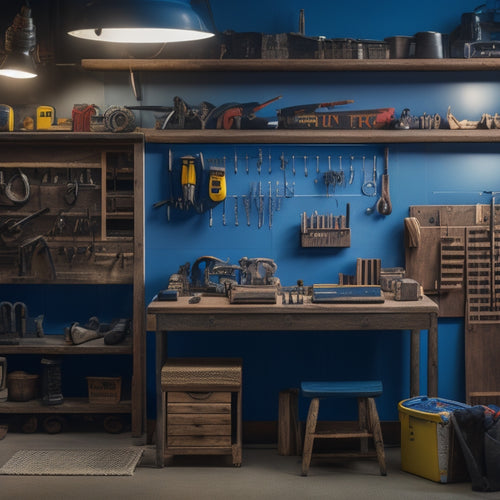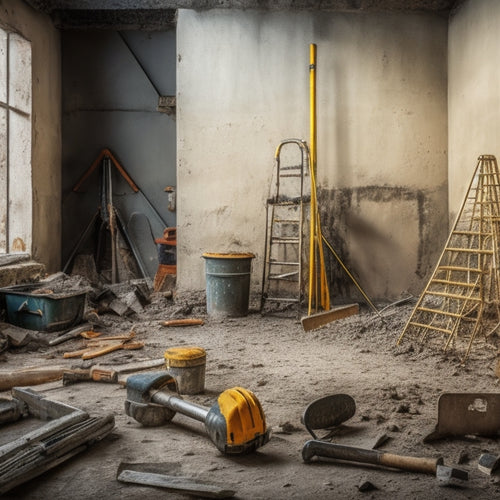
Accurate Measurements for Block Home Renovation Success
Share
When tackling a block home renovation, you'll need to take precise measurements at every stage to avoid costly mistakes, guarantee structural integrity, and achieve a successful project outcome. Invest in high-quality measuring tools like 25-foot tape measures, laser distance meters, digital calipers, and laser levels to guarantee accuracy. Measure block length and width accurately, calculate total block quantity needed, and account for waste factors. Verify window and door opening measurements, and guarantee walls are square and level. By following these best practices, you'll be well on your way to a successful renovation - and understanding the details of each measurement technique will make all the difference in your project's outcome.
Key Takeaways
• Use a combination of measuring tools, including tape measures, laser distance meters, and digital calipers, to ensure accurate measurements.
• Employ precise measurement techniques, such as standing at a 90-degree angle and verifying calculations, to minimize errors.
• Calculate total block quantity by multiplying length and width, including a 10-15% waste allowance, and maintain a detailed record of measurements.
• Measure window and door openings accurately, considering styles and types, and account for obstructions and block thickness.
• Verify wall squareness and levelness using diagonals and laser levels to ensure structural integrity and prevent costly mistakes.
Measuring Tools for Concrete Block
Measure the length, width, and height of the concrete block using a 25-foot tape measure or a laser distance meter to secure accurate calculations for your home renovation project.
Verify you're standing at a 90-degree angle to the block's surface to minimize measurement errors.
When using a tape measure, employ the 'hook and hold' technique, where you hook the tape's metal end to the block's edge and hold it firmly in place while taking readings.
For increased precision, consider using a laser distance meter, which can provide accurate measurements up to 1/16 of an inch.
Take note of the block wall thickness, as this will impact your calculations for the entire wall system.
Record your measurements carefully, and double-check your calculations to confirm accuracy.
Importance of Precise Calculations
Accurate calculations are essential in a home renovation project, as even slight miscalculations can lead to costly mistakes, delays, and structural weaknesses.
You must verify that your calculations are precise and reliable to avoid these issues.
When planning your renovation, you'll need to evaluate various factors, such as the size and layout of the rooms, the materials to be used, and the labor required.
To achieve accurate calculations, you'll need to employ effective measurement techniques, including taking precise measurements of the existing structure, identifying any potential obstacles, and accounting for any changes or modifications.
By doing so, you'll be able to create a thorough renovation plan that minimizes the risk of errors and guarantees a successful outcome.
Remember, precise calculations are critical to your renovation's success, and any mistakes can have serious consequences.
Types of Measurement Devices Needed
You'll require a range of specialized tools, including digital calipers, laser distance meters, and spirit levels, to take precise measurements of your home's layout, structure, and materials. These devices will help you capture accurate data, guaranteeing your renovation plans are executed flawlessly.
To get started, gather the following essential measurement devices:
-
Tape measures: flexible rulers that can be extended to measure distances up to 25 feet or more.
-
Measuring wheels: handy tools that calculate distances by rolling them across surfaces, ideal for measuring large areas like rooms or hallways.
-
Digital calipers: precise instruments for measuring small objects, such as door handles or window frames, with an accuracy of 0.01 mm.
- Spirit levels: tools that verify surfaces are perfectly level or plumb, vital for installing cabinets, shelves, or flooring.
With these devices at your disposal, you'll be able to collect accurate data, which will form the foundation of your renovation project. By using the right tools, you'll minimize errors and guarantee a successful outcome.
Laser Levels for Accuracy
When you're working on a home renovation project, you'll need to guarantee that your angles are precisely aligned and your heights are accurately measured.
That's where laser levels come in - these devices project a level line or point onto a surface, allowing you to quickly and easily check your work.
Precise Angle Alignment
By incorporating laser levels into your renovation toolkit, you can guarantee that surfaces, walls, and floors align precisely, eliminating costly mistakes and rework down the line.
This is vital in confirming that your renovation project turns out as planned, with perfect 90-degree angles and smooth connections between surfaces.
To achieve precise angle alignment, you'll need to master the following angle measurement techniques:
-
Check floor-to-wall connections: Verify that the floor and wall are perfectly level and plumb to prevent uneven surfaces.
-
Align wall studs: Confirm that wall studs are properly spaced and aligned to support heavy loads and prevent structural issues.
-
Measure ceiling-to-wall angles: Confirm that ceiling angles match wall angles to create a seamless joint.
- Verify countertop and cabinet alignment: Double-check that countertops and cabinets are properly aligned to guarantee a smooth, professional finish.
Accurate Height Measurement
Achieving accurate height measurements is critical in home renovation, as even slight deviations can compromise the structural integrity and aesthetic appeal of the entire project. You can't afford to rely on guesswork or rough estimates when it comes to measuring heights. To guarantee precision, you'll need to employ reliable height measurement techniques that meet stringent height measurement standards.
Laser levels are an excellent tool for achieving accurate height measurements. These devices project a level line or dot onto a surface, allowing you to measure heights with precision. By using a laser level, you can guarantee that your measurements are accurate to within a fraction of an inch. This is particularly important when working with materials like cabinetry, countertops, and flooring, where even slight deviations can have a significant impact on the overall appearance and functionality of the finished product.
When selecting a laser level, look for one that offers high accuracy and a long range. Some models can measure heights up to 100 feet or more, making them ideal for large-scale renovation projects. By investing in a high-quality laser level and following established height measurement standards, you can guarantee that your height measurements are accurate and reliable.
Digital Calipers for Precise Readings
Take precise measurements with digital calipers, which provide accurate readings to within 0.01 mm, ensuring that your home renovation project stays on track.
When choosing a digital caliper, consider the advantages they offer, such as speed, precision, and ease of use. You'll appreciate the convenience of instant readings and the ability to switch between units of measurement.
When selecting a digital caliper, consider the following key factors:
-
Material: Stainless steel or carbon fiber calipers offer durability and resistance to corrosion.
-
Accuracy: Look for calipers with high-precision sensors that provide accurate readings.
-
Resolution: Choose a caliper with a high resolution, such as 0.01 mm, for precise measurements.
- Battery life: Opt for a caliper with a long battery life to minimize interruptions.
Measuring Block Length and Width
You'll need to measure the length and width of blocks accurately to guarantee a precise fit and avoid costly mistakes in your home renovation project. To achieve this, it's crucial to understand the block dimensions and employ the right measurement techniques.
Start by identifying the type of block you're working with, as different blocks have unique dimensions. Take note of the block's nominal size, which is the stated size, and the actual size, which may vary slightly due to manufacturing tolerances.
Using digital calipers or a high-precision tape measure, take multiple measurements of the block's length and width to ensure accuracy. Record these measurements to the nearest 1/16 inch or 1 mm to maintain precision.
When measuring, ensure the block is on a level surface and the measuring instrument is perpendicular to the block face. Take care to avoid measuring over mortar joints or other obstructions that may affect the accuracy of your readings.
Calculating Block Quantity Needed
Determine the total square footage of the area to be covered by calculating the length and width of each section, then multiply these dimensions to get the total area. This will help you calculate the block quantity needed.
To achieve an accurate calculation, break down the area into smaller sections, considering corners, curves, and any obstructions. This will enable you to account for cuts and waste.
Here are some key considerations to keep in mind:
-
Block sizing techniques: Verify you're using the correct block size for your specific project, as this will impact your overall quantity calculation.
-
Estimating waste factors: Factor in a 10-15% waste allowance to account for cuts, broken blocks, and other unforeseen issues.
-
Sectional calculations: Calculate the square footage of each section separately to avoid errors.
- Rounding up: Always round up to the nearest whole number to guarantee you have enough blocks to complete the project.
Measuring for Window and Door Openings
When calculating block quantity, don't forget to account for window and door openings, which require precise measurements to confirm a proper fit and minimize waste.
You'll need to measure the width and height of each opening, taking into account the type of window or door you're installing. For windows, consider the style - are they casement, double-hung, or sliding? Each style has its own unique dimensions and requirements.
For doors, think about the type - are they standard, French, or patio doors? Measure the door's width, height, and threshold to confirm a seamless installation.
Take note of any obstructions, such as headers, sills, or jambs, which can affect the measurement. Be sure to record the measurements accurately, as even a small error can lead to costly mistakes.
Remember to account for the block's thickness and any necessary adjustments for mortar joints. By taking the time to measure window and door openings precisely, you'll confirm a professional-looking finish and avoid costly rework.
Ensuring Square and Level Walls
Accurate measurements for window and door openings are just the beginning; now, it's crucial to guarantee your walls are square and level, as even slight deviations can throw off the entire renovation.
You must confirm that your walls are perfectly plumb and level to avoid costly mistakes and structural issues.
To achieve this, you'll need to employ precise wall alignment techniques and block stacking strategies. Here are some key considerations to keep in mind:
-
Use a level and a string line to confirm the wall is straight and level.
-
Check for square by measuring the diagonals of the wall to verify they're equal.
-
Use a laser level to project a level line around the room, confirming all walls are aligned.
- Stack blocks carefully, using a level to guide each course and confirming the blocks are aligned with the string line.
Frequently Asked Questions
Can I Use a Regular Level for Measuring Block Home Renovations?
When considering block home renovations, you're likely wondering if a regular level will suffice for measuring. Unfortunately, a standard level mightn't provide the precision you need.
You'll want to explore specialized block level options that cater to the unique demands of block construction.
Invest in renovation accuracy tools, such as a laser level or a precision digital level, to guarantee accurate measurements and a successful renovation.
How Often Should I Re-Calibrate My Digital Calipers?
When working with digital calipers, you should re-calibrate them regularly to guarantee measurement accuracy.
The calibration frequency depends on usage, but as a general rule, you should recalibrate every 6-12 months or after 1,000-2,000 measurements.
Additionally, recalibrate whenever you drop the calipers, expose them to extreme temperatures, or notice inconsistent readings.
Follow the manufacturer's guidelines for calibration procedures to maintain peak measurement accuracy.
Are All Laser Levels Suitable for Indoor Measurement Tasks?
When selecting a laser level for indoor measurement tasks, you'll find that not all types are created equal.
You'll want to choose a level specifically designed for indoor use, such as a dot laser level or a line laser level, which provide high accuracy and precision.
These types offer superior indoor measurement accuracy, ensuring your measurements are reliable and accurate.
Be sure to evaluate the level's accuracy, range, and beam visibility when making your selection.
Can I Measure Block Length and Width With a Tape Measure?
You're about to start a measurement marathon, stretching your tape measure to its limits!
Can you really measure block length and width with a tape measure? Absolutely!
With precise tape measure techniques, you'll capture block dimensions with ease.
Extend the tape measure along the block's length, ensuring it's straight and level.
Then, record the measurement to the nearest 1/16 inch.
Repeat this process for the width, and you'll have accurate block dimensions in no time.
Do I Need to Measure for Electrical Outlet Openings Separately?
You'll need to measure for electrical outlet openings separately to verify accurate placement.
Outlet placement is governed by electrical codes, which dictate the distance between outlets and surrounding features.
Measure from the floor to the center of each outlet, and note the distance between outlets.
Don't assume standard spacing, as codes vary by region and outlet type.
Take precise measurements to confirm compliance and a safe, functional renovation.
Conclusion
As you wrap up your block home renovation, remember that precise measurements are the linchpin of success.
Measure twice, cut once - it's an old adage that still holds water. Inaccurate calculations can lead to costly mistakes, so don't take any chances.
With the right tools and a keen eye for detail, you'll be able to hit the nail on the head, ensuring a sturdy and aesthetically pleasing structure that will stand the test of time.
Related Posts
-

Budget-Friendly Materials for Your Home Renovation Project
As you plan your home renovation project, finding budget-friendly materials is key to turning your design vision into...
-

7 Smart Tool Organization Tips for Small Renovations
As you tackle your small renovation, you're likely wasting precious time searching for misplaced tools. To enhance ef...
-

What Tools to Rent for Block Wall Renovation
When renovating a block wall, it's vital to have the right tools for the job. You'll need demolition tools like pry b...


